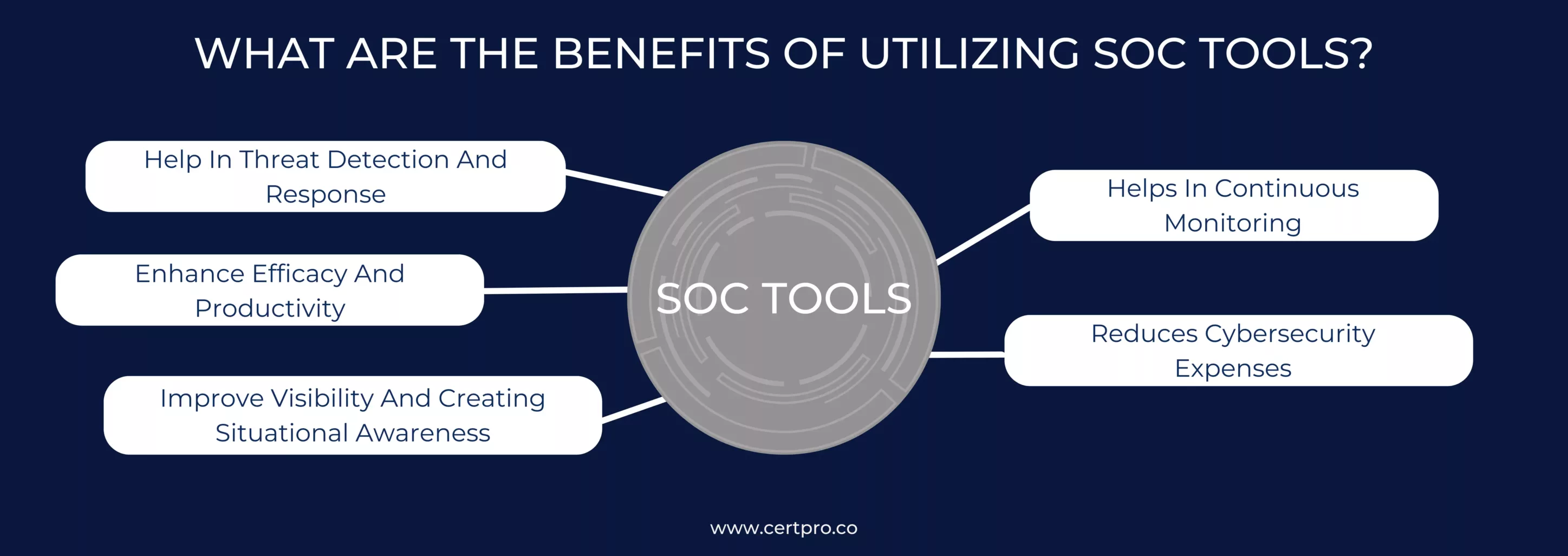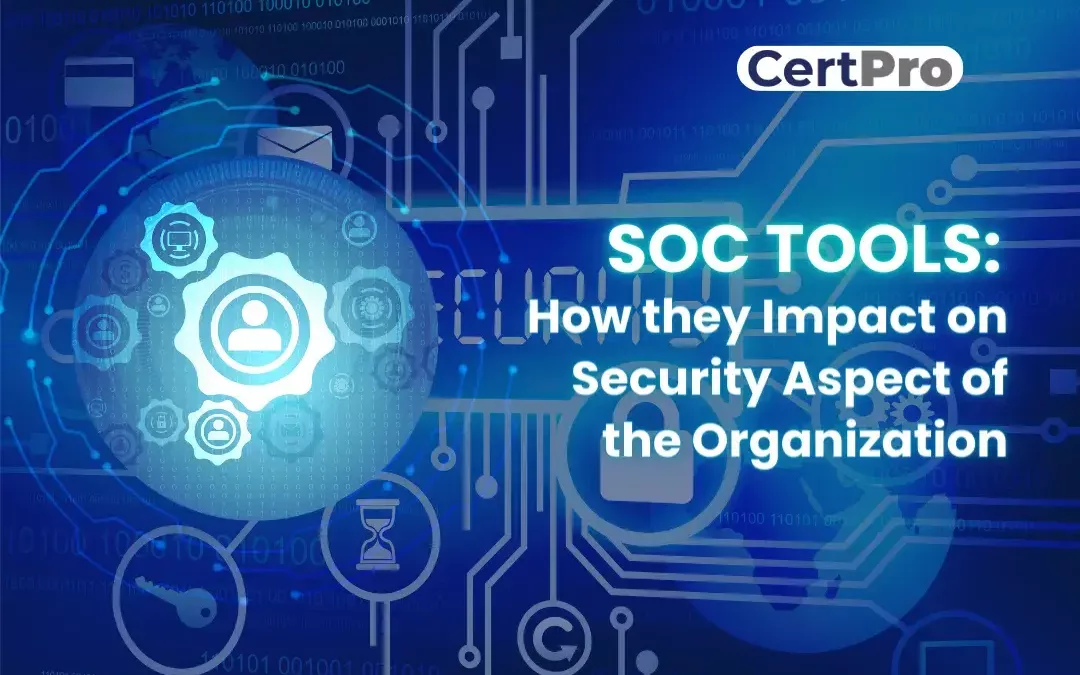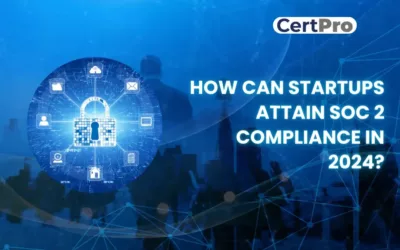The changing cybersecurity landscape increases the importance of Security Operations Center (SOC) tools. Hence, it is essential for strengthening digital defenses and protecting against cyberattacks. SOC tools help security teams detect, monitor, and prevent security issues in the company. Moreover, SOC tools ensure that your company strengthens its security aspects. It provides data collection, analysis, incident management, threat monitoring, and security. In today’s modern world, cyberattack threats make SOC tools and technologies more relevant. It ensures cybersecurity for your organization and helps in revenue generation.
This article will discuss the importance of SOC tools in detail. Furthermore, we will find out the impact of SOC tools on your business and also help you find the best SOC tools for your organization. In addition, this blog provides complete knowledge and practical solutions for optimizing cybersecurity defense aspects.
WHAT IS A SOC TOOL?
Security Operations Center (SOC) tools are unique software that helps identify and prevent your organization’s security risks. SOC tools work on data collection, analysis, and security management. Thus, it also helps with vulnerability management and threat monitoring. Additionally, it plays a vital role in improving an organization’s digital defenses. Thus, it provides complete tracking to ensure businesses are aware of and robust to evolving cyber threats. Therefore, SOC tools are vital for managing the digital defenses of the organization and creating a protective approach towards web-based threats. Hence, some important SOC tools are SIEM, EDR/XDR, IDS/IPS, Firewalls, Vulnerability scanners and many more. The efficacy of the tools can ensure the commitment of the service providers towards their existing clients. On a larger scale, it will increase the business capability of the service providers.
WHAT ARE THE TYPES OF SOC TOOLS AND TECHNOLOGIES?
SOC tools are important in identifying, preventing, and responding to cyber incidents. Thus, it integrates with an organization’s security architecture. Hence, it improves the ability to react quickly to security incidents. Therefore, using these technologies efficiently recognize the risks and conducts proactive measures to prevent them. This streamlined approach to security operations guarantees a proactive response to cyber threats. Moreover, it minimizes the impact of prospective breaches on the organization’s assets and reputation.
1. Vulnerability Management Tools: Vulnerability management involves the process of identifying and ranking the flaws within systems. Its applications enable timely solutions and fixes. Thus, this method ensures that security teams can adequately prioritize their efforts. SOC tools can strengthen the security aspect of your organization. It reduces the possibility of security threats being exploited by cyber attacker.
2. Data Collection and Analysis Tools: Data collection and analysis include obtaining information from networks, devices, and apps. This process involves collecting data from various sources to get insights into security threats and flaws. Therefore, the SOC tools list helps identify your organization’s patterns, trends, and risks. Thus, data collection and monitoring are essential for preventing cyberattacks.
3. Threat Intelligence: Threat intelligence is the collection and evaluation of prospective data regarding cyberattacks. This practice helps firms remain updated on the latest developments in the cyberattack landscape. Hence, these insights enable your organization to improve its defensive methods. Additionally, they work on detecting weaknesses and improving their overall cybersecurity posture.
4. Access Management Tools: Access management tools are critical security solutions that create data access authentication. These technologies are essential in preventing unwanted access to your organization’s data. Administrators have more control, which makes it easier to automate resource access. It strengthens security and protects against any breaches or data leaks. Moreover, it improves operational efficiency, tightens security processes, and ensures business compliance.
5. Security Incident and Event Management (SIEM): It is a comprehensive platform that gathers log data from multiple sources. In addition, it offers real-time security problem-solving insights. SIEM allows for the practical evaluation of network activities and identifies potential risks. It connects disparate events to uncover patterns indicative of security breaches. Security teams are better equipped to reduce risks and strengthen defenses against cyberattacks.
6. Security Orchestration, Automation, and Response (SOAR): SOAR is a cutting-edge technology designed to streamline incident response and reduce security breach risks. This innovative tool boasts advanced analysis and reporting features. Furthermore, SOAR offers seamless integration with other security tools, maximizing its effectiveness. Thus, SOAR empowers SOC teams to manage security incidents and improve cybersecurity defenses efficiently.
HOW DO YOU SELECT THE RIGHT SOC TOOL FOR YOUR ORGANIZATION?
When selecting the proper SOC tool for your firm, it’s important to consider factors such as:
- Functionality: Ensure that the tools can address your team’s security concerns. Flexibility with your specific needs is important for optimal performance.
- Ease of use: Consider the tools’ ease of use to guarantee that your team can quickly embrace them. Prioritize user friendliness to provide smooth integration into existing workflows.
- Integration: Check that the new tools enhance your security settings. Hence, testing integration allows you to seamlessly add new tools to what you already have. That results in a stronger security system overall.
- Scalability: Look for tools to scale up to meet your growing security needs. Furthermore, selecting scalable solutions ensures adaptability to future growth. Allowing seamless management of evolving security demands with efficiency and effectiveness.
WHAT ARE THE BENEFITS OF UTILIZING SOC TOOLS?
SOC tools provide many benefits for organizations, which include:
1. Help In Threat Detection And Response: It has been recognized that SOC tools bolster rapid identification and response to security threats. It curtails potential harm and operational downtime. These tools optimize incident management, ensuring swift detection and mitigation of risks. Thus safeguarding organizational assets and maintaining business continuity.
2. Enhance Efficacy And Productivity: SOC tools and technologies help enhance the organization’s efficiency and productivity. It automates repetitive task and offers centralized access to security data. Furthermore, it considers intricate investigations and strategic endeavors. Thus maximizing their effectiveness in safeguarding against threats.
3. Improve Visibility And Creating Situational Awareness: SOC tools enhance visibility and situational awareness. It offers a comprehensive perspective on your security stance. In addition, it helps in decision-making and implementing processes. Moreover, it avoids potential security breaches.
4. Helps In Continuous Monitoring: Cyberattacks are increasing day by day. Organizations must regularly monitor their IT infrastructure and data security to prevent such cyberattacks. Therefore, SOC tools can perform better in this aspect.
5. Reduces Cybersecurity Expenses: Cybersecurity expenses can be reduced with the help of the Security Operations Center (SOC) tools list. It allows organizations to share costs across departments, minimizing duplication and redundancy. Consequently, effective SOC tools and technologies can save money and time. Moreover, it prevents the risk of data breaches and ransomware attacks.

WHAT ARE THE POTENTIAL RISKS RELATED to SOC TOOLS?
During the planning stage, the auditor must consider the risks of using SOC tools. Examples of these risks include:
- Ensuring the tool coverage fits the service organization’s activities.
- The dependability of acquired information is dependent on the correct arrangement.
- The SOC tool application regularly collects data. SOC tool use may cause undue reliance on the organization.
- The tool may have operating gaps where controls are not tracked or monitored.
In summary, adding a SOC tool to your organization can improve security monitoring aspects. Hence, it enhances the business’s capabilities and ensures profit. This connection increases efficiency and assures greater compliance. Thus, it provides security requirements and consolidates all security work. The application makes the whole process simple and easy to manage. This simplifies security tasks and better prepares the firm for cyber attacks. However, knowing that this tool is helpful but only addresses some security concerns is essential. CertPro provides essential assistance in understanding SOC characteristics. Moreover, the certified experts can provide valuable advice on SOC features. You can contact CertPro at any moment to ensure continued support and assistance.
FAQ
Who Are the Primary Users of SOC Tools And Technologies?
SOC Tools and technologies are helpful for any service organization. It may include processes, stores, or any customer data-related organization.
Can I Use A Single SOC Tool For All Security Needs?
The type of tools depends on the size of your organization. SOC 2 mainly works on security monitoring and investigating solutions. It’s not worth using a single tool to cover all security aspects.
How Much Do SOC Tools Typically Cost?
Costs vary depending on the features, licensing models, and deployment options. Many vendors offer different pricing tiers based on the size and needs of the organization.
What Are The Future Trends In SOC Tools?
The updated trends in SOC technology are revolutionizing cybersecurity. It reduces the time it takes to detect and respond. It also automated streamlined processes, enabling swift identification and response to threats.
How CertPro Can Help Your Organization?
CertPro can guide you on adequately utilizing SOC Tools, and the expert auditing team can help you strengthen your data security.

About the Author
ANUPAM SAHA
Anupam Saha, an accomplished Audit Team Leader, possesses expertise in implementing and managing standards across diverse domains. Serving as an ISO 27001 Lead Auditor, Anupam spearheads the establishment and optimization of robust information security frameworks.
HOW CAN STARTUPS ATTAIN SOC 2 COMPLIANCE IN 2024?
Trust is crucial for startups to do well in today's digital world. It's vital for establishing credibility with clients, especially in a data-driven environment where privacy is the main component. Therefore, getting a SOC 2 compliance report is crucial to building...
WHAT IS SOC FOR CYBERSECURITY?
In today's fast-paced digital landscape, ensuring robust cybersecurity measures is imperative for organizations aiming to protect sensitive data and maintain stakeholder trust. The American Institute of CPAs (AICPA) crafted the SOC for cybersecurity reporting...
DOES SOC 2 COVER BUSINESS CONTINUITY?
System and Organization Controls (SOC) 2 is a comprehensive assessment used to confirm that an organization satisfies the standards set out by the American Institute of Certified Public Accountants (AICPA). This assessment looks at the Common Criteria, which cover a...




